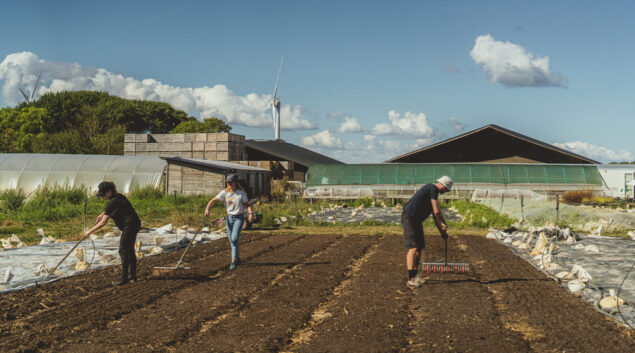
The current food system (which includes everything from production, transport, and processing, to packaging, storage, retail, consumption, as well as loss and waste) feeds the great majority of world population and supports the livelihoods of over 1 billion people. But our current food system is flawed.
The United Nations Food and Agriculture Organization (FAO) estimates that there is a need to produce about 60% more food by 2050 in order to feed the increasing world population.
Climate change is a growing threat to our food systems, with grim implications for food and nutrition security, livelihoods, and overall well-being, especially for poor and vulnerable people around the world – in fact, it has been estimated that these climate–related changes could cause global hunger and malnutrition to increase nearly 20% by 2050, impacting millions around the world.
A study of global vegetable and legume production concluded that if greenhouse gas emissions continue on their current trajectory, yields could fall by 35 percent by 2100 due to water scarcity and increased salinity and ozone.
The agriculture sector is one of the biggest emitters of CO2. However, this also means that it has a vital role to play in helping us end this crisis, and create a safe, sustainable future without carbon pollution. One where we can provide our booming world population with fresh, healthy food grown in a sustainable soil ecosystem. Our colleague Maja has spent her summer months immersing herself in regenerative agriculture and experiencing the techniques of sustainable farming. She explained to us the importance of regenerative farming and good quality soil as follows:
“When the world loses soil, food supply, drinking water and biodiversity are also threatened” she says. “Now with climate change, we experience more draughts, which leads to further degradation of our soils. So, the poor farming practices that we are applying now, which doesn’t align with how nature works, become even more problematic as our weather becomes more extreme. At the same time, this would lead to climate change because when soil degrades, it will release the carbon dioxide that would otherwise be stored in the soil. It can be seen as a vicious cycle – however, this is also a great opportunity because you can return it and start building the soil that will take on the carbon dioxide”.
Healthy soil and microorganisms are great helpers to the transition towards sustainable agriculture, because…
- … Soil is the world’s largest water filter.
- … Soil contains more than three times the amount of carbon in the earth’s atmosphere – which is crucial for climate change mitigation.
- … Soil is also the habitat for more than a quarter of the planet’s biodiversity and provides the basis for antibiotics. Most remarkably, in a single tablespoon of soil, there are 50 billion microbes alone.
Unfortunately, the way we currently grow the majority of our food, fiber, and fuel is actually damaging our planet’s ecosystem at an alarming rate through the loss of topsoil, loss of biodiversity, desertification, habitat destruction, and air and water pollution. Soil erosion (the number 1 threat to soil) alone could reduce crop yields by up to 10 percent by 2050.
Regenerative farming – the sustainable alternative practice to take action on climate change
Regenerative agriculture is a system of farming principles and practices that seeks to rehabilitate and enhance the entire ecosystem of the farm by placing a heavy premium on soil health with attention also paid to water management, fertilizer use, and more. It is a method of farming that “goes back to biology and science and understanding how the ecosystem works. From there, you will design the practices. In short, instead of forcing nature in a way we want it to work, we utilize the dynamics of nature that already exists” Maja explains.
The six key principles of regenerative farming:
- Don’t disturb the soil
- Keep the soil surface covered
- Keep living roots in the soil + more perennials
- Grow a diverse range of crops
- Close the nutrient cycle
- Bring rotational grazing animals back to land
What can we do to foster a more sustainable (and nutritious) future?
The sustainability of a food system begins well before a crop is grown or an animal is raised. This pre-production stage includes how genetic resources are conserved and used to improve the quality and productivity of domesticated crops and livestock for the future. It also includes agricultural innovation, such as fertilizer or crop protection products. During the production, farmers must contend with the many challenges involved in growing and harvesting, including pests and diseases, severe and unpredictable weather, and fluctuating market conditions. This is when the practice of regenerative farming becomes crucial.
The next step is the delivery of the food from the farmer to the consumer. Transformed into products that fit the market, these products can be processed, packaged, and stored before eventually being transported to where it is sold. Post-harvest food loss is an especially important issue across the developing world, where the infrastructure, energy grids and transport systems are often poor or missing. Moreover, a food system does not only capture how something is grown and harvested – it also includes how food is cooked, eaten, and disposed of by us – the consumers. Shifting our diets such that are heavy on meat and other animal products to such that are plant-based has a high potential for reducing carbon footprints and mitigating climate change, as well as improving human health, according to a report from the United Nations’ Intergovernmental Panel on Climate Change.
Also, by reducing our food waste, we can fight climate change, as it is estimated that a third of all food produced is thrown away before it even gets to the table.

To sum it up, changing farming practices to organic, regenerative and agroecological systems can increase soil organic carbon stocks, decrease greenhouse gas emissions, maintain yields, improve water retention and plant uptake, improve farm profitability, and revitalize traditional farming communities while ensuring biodiversity and resilience of ecosystem services. Regenerative organic agriculture is integral to the climate solution.
“Farming, bioeconomy, soil is the hotspot to look at because if you deal with the problems there, and you change the farming practices that we have today, and increase biomass, you will have a great knock-off effect on the many issues we have in agriculture.” Maja concludes.




